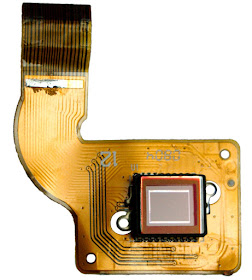Choosing right lens
In Part 1 I described how to, and WHY you should choose proper "type", focal length and quality of lens for your CCTV camera. But some people reported that this is not the full story - of course they are right.
If you want to choose proper lens for you camera, or chose a camera with better build in lenses you should also take a look at few more details.
The sensor...
Now you know that each camera has part called sensor. This "thing" gathers light and transforms it to digital signal.
I will write another post about sensors where I will put more information, but the most important thing that you need to know now is - the bigger the sensor, the better low light performance and better image quality.
This is simple. Just look at your cell phone camera. 8, 12 or even 16 MPx cameras build in the cell phone, but just look at that thing! Small, tiny camera, and why in the name of Cthulhu my cellphone with 12MPx camera makes more shitty pictures than DSL camera with 6MPxel?!
The answer is - THE SENSOR!
 |
| CCD sensor [1] |
Bigger sensor - bigger area that can gather photons = more photons = more details and better low light performance, less noise, better dynamic range etc.
One of the first sensors used in digital cameras was Kodak (by Steven Sasson) Prototype with resolution of 0.01 MEGAPIXEL! Invented in 1975.
Sensor sizes are expressed in inches notation because at the time of the popularization of digital image sensors they were used to replace video camera tubes.
I know this is stupid, using something different than metric system is stupid. But hey! I can't change that... yet... So sorry people from USA, but you are wrong.
 |
| Metric system. USE IT! |
So, to make things simple, to check size of sensor look in to the datasheet of a camera and check "sensor type" or "sensor size". The bigger - the better
Usually in cellphone cameras manufacturers use 1/4" -1/3" sensor, In CCTV cameras standard is 1/2.8" for FullHD good 3.1MPx camera. If there is 1/3" it will be good at day and in good lighting, but poor at night comparing to bigger sensors. And YES! There is HUGE difference between 1/3" and 1/2,8"
Everything more than 1/2" in CCTV is VERY GOOD and will blow your mind, it's impressive and will do the job.
 |
| [2] Sensor size |
But keep in mind that more pixels mean that the "holes" that gather photons on sensors needs to be smaller. Resolution is getting bigger, but the area of the sensor is not.
So 2.0 MPxel camera on 1/1.8" sensor will produce much better image in low light than 6MPx on the same sensor.
This is important.
...and the hole.
Ok so if you know what sensor your camera use, you can take a look at the "hole" od your lens.
When you choose lens - focal length and resolution is important, but the most important thing is size (and the aperture).
As you probably noticed (I know you are smart) sensor is rectangular (or square) and the lens is round, so it needs to fit the sensor.
 |
| [3] Lens - round Sensor - rectangular |
 |
| When lens doesn't fit your sesnor |
Your lens needs to be the same size or bigger than the sensor, that't it.
So when you check datasheet you need to take a look at the "size" or "sensor type".
Just choose lens that are the same size, or bigger than the sensor.
For example - you can use 12MPx 1/1.7" Dahua lens on your 2.0MPx 1/2.8" camera.
It wont affect image quality.
But if you use 1/2.8" lens on 1/1.8" Sensor camera you will get this effect:
Weird wide angle and pixel distribution, black corners + poor image quality.
So now we have proper size, Next part - APERTURE of the lens.... but this is topic for next post, I will finish it this week :)
Stay tuned, like and subscribe!
[1] Wikipedia https://en.wikipedia.org/wiki/Image_sensor#/media/File:Ccd-sensor.jpg
[2] http://www.theautomotiveindia.com/forums/gadgets-more/1433-dslr-information-thread-27.html
[3] http://www.ussscctv.com/lenscalculatorandselectionguide.aspx

No comments:
Post a Comment